
Chenopodium
Encyclopedia
- "Goosefoot" redirects here. The unrelated smearwortSmearwortSmearwort , also known as Round-leaved Birthwort, English Mercury, Mercury Goosefoot, Allgood, Tola Bona or "Fat Hen", is a herbaceous perennial plant native to Southern Europe.-Etymology:...
(Aristolochia rotunda) is sometimes called "Mercury goosefoot".
Chenopodium is a genus
Genus
In biology, a genus is a low-level taxonomic rank used in the biological classification of living and fossil organisms, which is an example of definition by genus and differentia...
of about 150 species
Species
In biology, a species is one of the basic units of biological classification and a taxonomic rank. A species is often defined as a group of organisms capable of interbreeding and producing fertile offspring. While in many cases this definition is adequate, more precise or differing measures are...
of perennial or annual
Annual plant
An annual plant is a plant that usually germinates, flowers, and dies in a year or season. True annuals will only live longer than a year if they are prevented from setting seed...
herbaceous
Herbaceous
A herbaceous plant is a plant that has leaves and stems that die down at the end of the growing season to the soil level. They have no persistent woody stem above ground...
flowering plant
Flowering plant
The flowering plants , also known as Angiospermae or Magnoliophyta, are the most diverse group of land plants. Angiosperms are seed-producing plants like the gymnosperms and can be distinguished from the gymnosperms by a series of synapomorphies...
s known as the goosefoots, which occur almost anywhere in the world. It is placed in the family
Family (biology)
In biological classification, family is* a taxonomic rank. Other well-known ranks are life, domain, kingdom, phylum, class, order, genus, and species, with family fitting between order and genus. As for the other well-known ranks, there is the option of an immediately lower rank, indicated by the...
Amaranthaceae
Amaranthaceae
The flowering plant family Amaranthaceae, the Amaranth family, contains about 176 genera and 2,400 species.- Description :Most of these species are herbs or subshrubs; very few are trees or climbers. Some species are succulent....
in the APG II system
APG II system
The APG II system of plant classification is the second, now obsolete, version of a modern, mostly molecular-based, system of plant taxonomy that was published in April 2003 by the Angiosperm Phylogeny Group. It was a revision of the first APG system, published in 1998, and was superseded in 2009...
; older classifications separate it and its relatives as Chenopodiaceae
Chenopodiaceae
Chenopodiaceae were a family of flowering plants, also called the Goosefoot Family. They are now included within family Amaranthaceae. The vast majority of Chenopods are weeds, and many are salt and drought tolerant. A few food crops also belong to the family: spinach, beets, chard, quinoa, and...
, but this leaves the rest of the Amaranthaceae polyphyletic. However, among the Amaranthaceae, the genus Chenopodium is the namesake member of the subfamily Chenopodioideae
Chenopodioideae
The Chenopodioideae is a subfamily of the flowering plant family Amaranthaceae, formerly classified in family Chenopodiaceae.Food species include several Chenopodium species , Orache , and Spinach .-Genera:The subfamily includes about 25 genera.* Tribus Atripliceae C. A...
. The genus Dysphania is closely related, and contains several species formerly placed in Chenopodium, such as epazote (D. ambrosioides).
In Australia
Australia
Australia , officially the Commonwealth of Australia, is a country in the Southern Hemisphere comprising the mainland of the Australian continent, the island of Tasmania, and numerous smaller islands in the Indian and Pacific Oceans. It is the world's sixth-largest country by total area...
, the larger Chenopodium species are among the plants called "bluebush
Bluebush
-Plants:* Acacia brachybotrya of Australia* Acacia caesiella of Australia* Chenopodium species in Australia* Diospyros lycioides of Africa* Maireana, the bluebushes proper...
es". Chualar
Chualar, California
Chualar is a census-designated place in Monterey County, California, United States. Chualar is located southeast of Salinas, at an elevation of 115 feet...
in California
California
California is a state located on the West Coast of the United States. It is by far the most populous U.S. state, and the third-largest by land area...
is named after a Native American
Native Americans in the United States
Native Americans in the United States are the indigenous peoples in North America within the boundaries of the present-day continental United States, parts of Alaska, and the island state of Hawaii. They are composed of numerous, distinct tribes, states, and ethnic groups, many of which survive as...
term for a goosefoot abundant in the region, probably the California goosefoot (C. californicum).
Uses and ecology
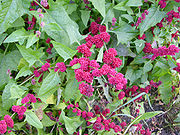
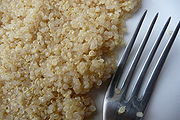
Food
Food is any substance consumed to provide nutritional support for the body. It is usually of plant or animal origin, and contains essential nutrients, such as carbohydrates, fats, proteins, vitamins, or minerals...
crops as leaf vegetable
Leaf vegetable
Leaf vegetables, also called potherbs, green vegetables, greens, leafy greens or salad greens, are plant leaves eaten as a vegetable, sometimes accompanied by tender petioles and shoots...
s – used like the closely related spinach
Spinach
Spinach is an edible flowering plant in the family of Amaranthaceae. It is native to central and southwestern Asia. It is an annual plant , which grows to a height of up to 30 cm. Spinach may survive over winter in temperate regions...
(Spinacia oleracea) and similar plants called quelite
Quelite
Quelite can mean any of a number of different plants eaten in Mexico for their leaves, as leaf vegetables or herbs, including but not limited to:* Amaranthus species* Chenopodium species* Coriandrum speciesSee also:...
in Mexico
Mexico
The United Mexican States , commonly known as Mexico , is a federal constitutional republic in North America. It is bordered on the north by the United States; on the south and west by the Pacific Ocean; on the southeast by Guatemala, Belize, and the Caribbean Sea; and on the east by the Gulf of...
– and pseudocereal
Pseudocereal
Pseudocereals are broadleaf plants that are used in much the same way as cereals . Their seed can be ground into flour and otherwise used as cereals. Examples of pseudocereals are amaranth, Love-lies-bleeding, red amaranth, Prince-of-Wales-feather, quinoa, and buckwheat.- Pseudocereals :...
s. These include white goosefoot (C. album), Good King Henry
Good King Henry
Good King Henry , also called Poor-man's Asparagus, Perennial Goosefoot, Lincolnshire Spinach or Markeryis a species of goosefoot which is native to much of central and southern Europe....
(C. bonus-henricus), strawberry blite (C. capitatum), leafy goosefoot (C. foliosum), kañiwa
Kañiwa
Chenopodium pallidicaule, sometimes known as Cañihua, Canihua, Kañiwa, is a species of goosefoot, similar in character and uses to the closely related quinoa....
(C. pallidicaule) and quinoa
Quinoa
Quinoa , a species of goosefoot , is a grain-like crop grown primarily for its edible seeds. It is a pseudocereal rather than a true cereal, or grain, as it is not a member of the grass family...
(C. quinoa). On the Greek
Greece
Greece , officially the Hellenic Republic , and historically Hellas or the Republic of Greece in English, is a country in southeastern Europe....
island of Crete
Crete
Crete is the largest and most populous of the Greek islands, the fifth largest island in the Mediterranean Sea, and one of the thirteen administrative regions of Greece. It forms a significant part of the economy and cultural heritage of Greece while retaining its own local cultural traits...
, tender shoots and leaves of a species called krouvida (κρουβίδα) or psarovlito (ψαρόβλητο) is eaten by the locals, boiled or steamed. As studied by Kristen Gremillion
Kristen gremillion
Kristen Johnson Gremillion is an American anthropologist whose areas of specialization include paleoethnobotany, origins of agriculture, the prehistory of eastern North America, human paleoecology and paleodiet, and the evolutionary theory...
and others, goosefoots have a history of culinary use dating back to 4000 BC or earlier, when pitseed goosefoot (C. berlandieri) was a staple crop in the Native American eastern agricultural complex
Eastern Agricultural Complex
The Eastern Agricultural Complex describes the agricultural practices of the pre-historic Eastern Woodland Native Americans in the eastern United States and Canada. Native Americans domesticated and cultivated many indigenous crops as far west as the Great Plains.-Term:The term Eastern Agricultural...
, and white goosefoot was apparently used by the Ertebølle culture
Ertebølle culture
The Ertebølle culture is the name of a hunter-gatherer and fisher, pottery-making culture dating to the end of the Mesolithic period. The culture was concentrated in Southern Scandinavia, but genetically linked to strongly related cultures in Northern Germany and the Northern Netherlands...
of Europe
Europe
Europe is, by convention, one of the world's seven continents. Comprising the westernmost peninsula of Eurasia, Europe is generally 'divided' from Asia to its east by the watershed divides of the Ural and Caucasus Mountains, the Ural River, the Caspian and Black Seas, and the waterways connecting...
.
There is increased interest in particular in goosefoot seeds today, which are suitable as part of a gluten-free diet
Gluten-free diet
A gluten-free diet is a diet that excludes foods containing gluten. Gluten is a protein found in wheat , barley, rye, malts and triticale. It is used as a food additive in the form of a flavoring, stabilizing or thickening agent, often as "dextrin"...
. Quinoa oil
Quinoa oil
Quinoa oil is a vegetable oil extracted from germ of the Chenopodium quinoa, an Andean cereal and has been cultivated since at least 3000 B.C. Quinoa itself has attracted considerable interest as a source of protein, but the oil derived from quinoa is of interest in its own right...
, extracted from the seeds of C. quinoa, has similar properties, but is superior in quality, to corn oil
Corn oil
Corn oil is oil extracted from the germ of corn . Its main use is in cooking, where its high smoke point makes refined corn oil a valuable frying oil. It is also a key ingredient in some margarines. Corn oil is generally less expensive than most other types of vegetable oils. One bushel of corn...
. Oil of chenopodium is extracted from the seeds of epazote, which is not in this genus anymore. Shagreen
Shagreen
Shagreen is a type of leather or rawhide consisting of rough untanned skin, formerly made from a horse's back or that of an onager . Shagreen is now commonly made of the skins of sharks and rays....
leather was produced in the past using the small, hard goosefoot seeds. C. album was one of the main model organism
Model organism
A model organism is a non-human species that is extensively studied to understand particular biological phenomena, with the expectation that discoveries made in the organism model will provide insight into the workings of other organisms. Model organisms are in vivo models and are widely used to...
s for the molecular biological study of chlorophyllase
Chlorophyllase
Chlorophyllase is the key enzyme in chlorophyll metabolism. It is a membrane protein that is commonly known as Chlase and systematically known as chlorophyll chlorophyllidohydrolase. Chlorophyllase can be found in the chloroplast, thylakoid membrane and etioplast of at least higher plants such as...
.
Goosefoot pollen
Pollen
Pollen is a fine to coarse powder containing the microgametophytes of seed plants, which produce the male gametes . Pollen grains have a hard coat that protects the sperm cells during the process of their movement from the stamens to the pistil of flowering plants or from the male cone to the...
, in particular of the widespread and usually abundant C. album, is an allergen
Allergen
An allergen is any substance that can cause an allergy. In technical terms, an allergen is a non-parasitic antigen capable of stimulating a type-I hypersensitivity reaction in atopic individuals....
to many people and a common cause of hay fever
Hay Fever
Hay Fever is a comic play written by Noël Coward in 1924 and first produced in 1925 with Marie Tempest as the first Judith Bliss. Laura Hope Crews played the role in New York...
. The same species, as well as some others, have seeds which are able to persist for years in the soil seed bank
Soil Seed Bank
The soil seed bank refers to the natural storage of seeds, often dormant, within the soil of most ecosystems. The study of soil seed banks started in 1859 when Charles Darwin observed the emergence of seedlings using soil samples from the bottom of a lake. The first scientific paper on the subject...
. Many goosefoot species are thus significant weed
Weed
A weed in a general sense is a plant that is considered by the user of the term to be a nuisance, and normally applied to unwanted plants in human-controlled settings, especially farm fields and gardens, but also lawns, parks, woods, and other areas. More specifically, the term is often used to...
s, and some have become invasive species
Invasive species
"Invasive species", or invasive exotics, is a nomenclature term and categorization phrase used for flora and fauna, and for specific restoration-preservation processes in native habitats, with several definitions....
.
Certain species grow in large thicket
Thicket
A thicket is a very dense stand of trees or tall shrubs, often dominated by only one or a few species, to the exclusion of all others. They may be formed by species that shed large amounts of highly viable seeds that are able to germinate in the shelter of the maternal plants.In some conditions the...
s, providing cover for small animals. Goosefoot foliage is used as food by the caterpillar
Caterpillar
Caterpillars are the larval form of members of the order Lepidoptera . They are mostly herbivorous in food habit, although some species are insectivorous. Caterpillars are voracious feeders and many of them are considered to be pests in agriculture...
s of certain Lepidoptera
Lepidoptera
Lepidoptera is a large order of insects that includes moths and butterflies . It is one of the most widespread and widely recognizable insect orders in the world, encompassing moths and the three superfamilies of butterflies, skipper butterflies, and moth-butterflies...
. The seeds are eaten by many bird
Bird
Birds are feathered, winged, bipedal, endothermic , egg-laying, vertebrate animals. Around 10,000 living species and 188 families makes them the most speciose class of tetrapod vertebrates. They inhabit ecosystems across the globe, from the Arctic to the Antarctic. Extant birds range in size from...
s, such as the yellowhammer
Yellowhammer
The Yellowhammer, Emberiza citrinella, is a passerine bird in the bunting family Emberizidae. It is common in all sorts of open areas with some scrub or trees and form small flocks in winter....
(Emberiza citrinella) of Europe or the white-winged fairy-wren
White-winged Fairy-wren
The White-winged Fairywren is a species of passerine bird in the fairywren family Maluridae. It lives in the drier parts of central Australia; from central Queensland and South Australia across to Western Australia...
(Malurus leucopterus) of Australia
Australia
Australia , officially the Commonwealth of Australia, is a country in the Southern Hemisphere comprising the mainland of the Australian continent, the island of Tasmania, and numerous smaller islands in the Indian and Pacific Oceans. It is the world's sixth-largest country by total area...
. Goosefoot pathogens include the positive-sense ssRNA viruses - apple stem grooving virus
Apple stem grooving virus
Apple stem grooving virus is a plant pathogenic virus of the family Flexiviridae.-External links:**...
, sowbane mosaic virus
Sowbane mosaic virus
Sowbane mosaic virus is a pathogenic plant virus.-External links:**...
and tobacco necrosis virus
Tobacco necrosis virus
Tobacco necrosis virus is a plant virus of the family Tombusviridae.It is transmitted by the fungus Olpidium brassicae.-General Properties of TNV:TNV has wide host range . The virus can be isolated from roots of...
.
Selected species
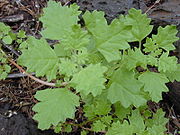

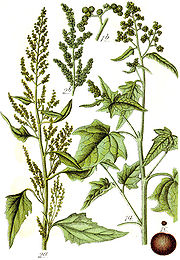
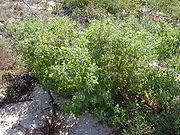
- Dysphania
- Rhagodia baccataRhagodia baccataRhagodia baccata, commonly known as Berry Saltbush, is a species of shrub endemic to Western Australia.-Description:It is a spreading shrub up to two metres high, with elliptical leaves, and flowers that occur in a panicle. It bears red berries....
– berry saltbush (as C. baccatum) - Suaeda australisSuaeda australisSuaeda australis ' is a species of plant in the family Amaranthaceae, native to Australia. It grows to between 0.1 and 0.9 metres in height, with a speading habit and branching occurring from the base. The leaves are up to 40mm in length and are succulent, linear and flattened. They are light...
– austral seablite (as C. australe, C. insulare)

